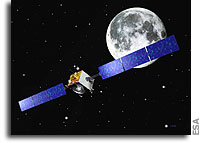SMART-1 is flying at full speed through the Earth radiation belts

Summary of overall status, current activities and planned activities
The spacecraft is now in its 90th orbit and has been behaving really well during the last five days. The last anomaly, an Electric Propulsion flame out, occurred on November 5. From then, SMART-1 has operated flawlessly. In this same period the solar activity has dropped considerably. This has been mainly due to the rotation of the solar disk, which has moved the active sunspot regions away from the Earth direction. This is an indirect confirmation of the suspicions that many of the problems the spacecraft was experiencing last week were caused by the intense radiation environment.
The spacecraft was operated in electric propulsion mode almost continuously, only interrupting it during the eclipses where the power available from the batteries cannot sustain the high demand of the engine. The total cumulated thrust time is now more than 520 hours and we have consumed about 8.2 kg of Xenon fuel. Moreover, the electric propulsion engine performance, periodically monitored by means of the telemetry data transmitted by the spacecraft and by radio-tracking by the ground stations, has shown a further increase in performance. We have now a thrust from 1.5% to 1.8% higher than expected. These are very encouraging results – let us hope that we can even recover the time lost during last week’s solar storms.
The electric power produced by the solar arrays continues to be affected, as expected, by the radiation environment. We register on average a loss of less than 2 W per day. This degradation should last until the trajectory crosses the radiation belts – roughly a month away. At this rate the solar arrays will have lost about 130 W at the exit of the radiation belts. Due to the built in power margins, this will allow the spacecraft to continue thrusting at full power, hence shortening the time envisaged to reach the Moon. Of course, this is provided that we encounter another exceptional solar storm in the near future.
The communication, data handling and on-board software subsystems have been performing very well in this period.
The thermal subsystem also continues to perform well and all the temperatures are as expected. The only item of concern is the temperature of one of the star tracker optical heads which is slightly too high (>10 °C) during part of the orbit. The star trackers have become more sensitive to temperature, due to the aging produced on the CCD by the massive radiation dose received in the last weeks. This causes momentary loss of attitude determination by that star tracker. This is without consequence, as there is another star tracker, which provides good attitude determination and the system is capable of coping for periods without both star trackers. Nevertheless, thermal engineers are still looking into the possibility of reducing the temperature of the star tracker optical heads.
Apart from the above problem of the star trackers, the attitude control subsystem continues to work very well in general.
Presently only the two diagnostic plasma instruments (EPDP and SPEDE) are being regularly operated. We are, however, planning to make some test observations with the AMIE camera as soon as possible. The main objective at the moment is still to completely exit the radiation belts as quickly as possible. We are, therefore, first investigating if any interesting target, like the Moon or the Earth, enters AMIE field of view, without requiring a slew manoeuvre. These potential targets are currently being analysed. As soon as a target is identified we shall make test observations with AMIE. Before operating SIR and D-CIXS, we shall wait until the spacecraft is completely outside the potentially dangerous radiation belts.
Orbital/Trajectory information
The SMART-1 orbit is continuously modified by the effects of the electric propulsion low thrust. The osculating orbital elements are periodically computed by the ESOC specialists. These elements define the so called ìosculating orbitî which would be travelled by the spacecraft if at that instant all perturbations, including EP thrust, would cease. So it is an image of the situation at that epoch. In reality the path travelled by the spacecraft is a continuous spiral leading from one orbit to another. The most recent osculating elements are as follows:
EPOCH (UTC) 2003/11/02 04:02:06.2 Elements WRT Earth (J2000) | |
| Pericentre Distance (km) | 10002.821984 |
| Apocentre Distance (km) | 45627.954139 |
| Semi Major Axis (km) | 27815.388062 |
| Eccentricity | 0.640385 |
| Inclination (deg) | 6.871229 |
| Asc. Node (deg) | 157.153123 |
| Arg. of Pericentre (deg) | 200.659621 |
| True Anomaly (deg) | 179.777703 |
| Osc. Orbital Period (h) | 12.824374 |
 |
SMART-1 orbit |
From start, the electric propulsion system has managed to increase the semi-major axis of the orbit by 3185 km, increasing the perigee altitude from the original 656 km to 3624 km and the orbital period by more than 2 hours, from the initial 10 hours 41 minutes to the present 12 hours 49 minutes.








